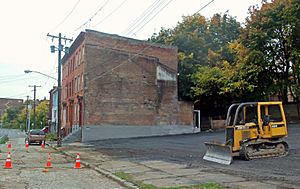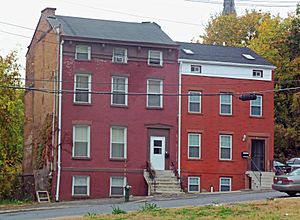Broadway–Livingston Avenue Historic District facts for kids
Quick facts for kids |
|
|
Broadway–Livingston Avenue
Historic District |
|

View north along Broadway to railroad bridge, 2011
|
|
| Location | Albany, New York |
|---|---|
| Area | 3.5 acres (1.4 ha) |
| Architect | Multiple |
| Architectural style | Greek Revival, Italianate, Warren Truss |
| NRHP reference No. | 87002300 |
| Added to NRHP | January 7, 1988 |
The Broadway–Livingston Avenue Historic District is a special area in Albany, New York. It's found where Broadway and Livingston Avenue meet. This district includes seven old buildings and a unique railroad bridge. These buildings are called "contributing properties" because they help show the area's history. In 1988, this district was added to the National Register of Historic Places. This means it's officially recognized as an important historical place.
This area is the only place north of downtown Albany that still has many 19th-century shops and homes. Most buildings are two or three stories tall. They were built between 1829 and 1876. This was a busy time for the neighborhood. It was the eastern end of the Erie Canal, a very important waterway. The railroad bridge was built in 1900. It carries train tracks over Broadway.
Many buildings around the district were torn down in the 1960s and 70s. This was part of "urban renewal" plans to modernize the city. Even within the district, many buildings were in poor shape. More than half have been demolished since 1988. This has left empty lots. The remaining buildings still show signs of wear and tear. However, some have started to be fixed up in the 2010s. Because so many buildings are gone, local groups think this district is one of Albany's most endangered historic sites.
Contents
Exploring the Broadway–Livingston Avenue Historic District
The district covers about 3.5 acres. It has an unusual shape. It includes land on both sides of Broadway and Livingston Avenue. It stretches north and west from their intersection. It goes up to the railroad bridge, but not the intersection itself. This area is just north of downtown Albany. Here, the big city buildings give way to smaller two-story homes. To the east, the land is flat. It leads to the Hudson River, about a quarter-mile away.
To the west, the ground starts to rise towards Pearl Street. The Church of Holy Innocents is nearby. It is also a historic site. Further west is the large Arbor Hill Historic District–Ten Broeck Triangle. This is another important historic area. Across Pearl Street, there is a modern housing complex. It has tall towers and smaller apartment buildings. One block south, you can find the Broadway Row. These are four brick rowhouses also listed on the Register.
The district's developed parts are on the west side of Broadway and the south side of Livingston. Most buildings here are made of brick. They date back to the district's most important historical period. Most are one or two-story homes or shops. The empty lots on the east side are now a small shopping area and gas station. A line of trees runs along the railroad tracks.
A Look Back: History of the District
Albany started as a small, walled town in 1686. It was mostly just its downtown area. The city's official boundary stretched about a mile north along the Hudson River. The land to the north belonged to the van Rensselaer family. They were the original "patroons," or landowners, from when the Dutch first settled the area.
In 1764, Stephen van Rensselaer II had the land north of Albany surveyed. It was laid out in a grid pattern for future streets. Then, it was divided into smaller lots and sold. This area became the town of Colonie in 1795. By 1815, about a thousand people lived there. They convinced Albany to make Colonie part of the city. It became Albany's Fifth Ward.
The Erie Canal and Railroads Bring Growth
A big change happened in 1825. The Erie Canal was finished. This 360-mile waterway ended right where Colonie Street meets the Hudson River. The city built a large complex there. North Broadway began to grow quickly. The neighborhood became known as the "lumber district." Much of the wood from the Adirondack Mountains came through the canal. New buildings included mills to finish the wood. Homes for the people who became rich from shipping also appeared.
Railroads also changed the area. In 1831, the first passenger steam train service in the U.S. started. It ran between Albany and Schenectady. Later, in 1844, the train tracks were moved. A large freight area was built nearby. Here, goods were moved from trains to boats. Workers for this busy operation settled in the neighborhood. Small businesses opened to serve them.
After the American Civil War, a bridge was built. This made the neighborhood a bit less important for trade. But new buildings, like 810–812 Broadway, were still built. Canal traffic also slowed down as railroads improved. In 1900, the current Warren truss iron bridge was built. This was part of a big project to improve the city's railroads. A new bridge across the Hudson replaced the old one. A new train station, Union Station, was built downtown. The old Broadway station was torn down. The canal was filled in for more train yards. These changes took away the neighborhood's main economic focus.
Modern Times: Decline and Renewal
The district slowly declined during the 20th century. Most buildings outside the current district were torn down in the 1960s and 70s. Even after the district was listed as historic, more buildings have been lost.
However, in the 2010s, some buildings began to be fixed up. In 2017, a developer named Michael Chiou started renovating 800–804 Broadway. These were the last buildings on that block. They were in very bad shape. By the end of 2019, the work was done. Fifteen new apartments were created. Chiou said, "It's a very blighted street that people kind of forgot about."
In 2019, as part of a project to build Clinton Square Studios, two buildings at 70 and 72 Livingston were updated. This project created affordable housing for actors. But across the street, 67 Livingston is planned to be torn down.
Important Buildings in the District
Out of the original 20 buildings in the district, only seven remain. The railroad bridge is also still there.
- 70 and 72 Livingston Avenue. These two buildings are identical. They are two-and-a-half stories tall. They show the Greek Revival style. They were built around 1840. They are the oldest buildings still standing in the district.
- Railroad bridge, over Broadway at Colonie Street. This metal bridge once carried four train tracks. Now, three remain. It is a Warren truss bridge. This means it has a special zigzag pattern of metal beams. These beams rest on stone supports called abutments. The bridge carries Amtrak passenger trains and CSX freight trains.
One notable building that was torn down was 788 Broadway. It was a Greek Revival townhouse built in 1829. It was the oldest building in the district. It had special columns and decorations.
In 2012, the buildings at 808 and 810–812 Broadway were demolished. The latter was a three-story building. It was built in 1872 in the Italianate style. It was the most decorated building left. It had tall columns and fancy designs.
Across the street, 799 Broadway was also torn down. It was built in 1835. It became a police station in 1863. It had some updates over the years. These included new windows and a different entrance.
Images for kids






